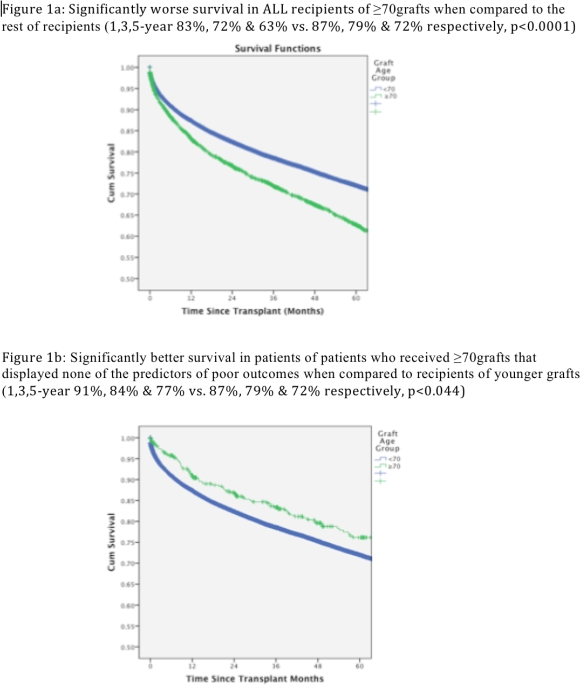A Users Guide to Maximizing Utility and Outcome in >70 Year Old Donors.
Liver Transplant & HPB Surgery, Weill Cornell Medical College, NY, NY.
Meeting: 2016 American Transplant Congress
Abstract number: 525
Keywords: Donors, Elderly patients, Liver grafts, marginal
Session Information
Session Name: Concurrent Session: Liver: MELD, Allocation and Donor Issues (DCD/ECD) 2
Session Type: Concurrent Session
Date: Tuesday, June 14, 2016
Session Time: 4:30pm-6:00pm
 Presentation Time: 4:42pm-4:54pm
Presentation Time: 4:42pm-4:54pm
Location: Room 304
Background Among 10 million stroke fatalities in the US since 2002, donated livers were recovered from 28,313. Unfortunately, only 2,402 livers were yielded from 7.5 million patients ≥70 who died of stroke (0.03%). Despite reports of successful OLT with older livers, advanced donor age is considered a risk factor for poor outcomes. CMS definitions of an “eligible death” for donation excludes patients >70, creating a disincentive to explore donation. We propose that these donors are under-utilized and sought to investigate the utility and outcomes of livers from donors ≥70 (≥70grafts).
Methods Analysis of UNOS Star file of adult OLTs performed between 1/2002 and 9/2014. Kaplan-Meier curves were used for survival analysis and Cox regression used to identify factors influencing outcomes in recipients of ≥70 grafts.
Results A total of 3,110 livers ≥70 were included. Over half of these (55%) were used in 3 regions, regions 2 (480/3110), 3 (520/3110) & 9 (699/3110). Survival was significantly worse among recipients of ≥70grafts compared to recipients of younger grafts (p<0.0001, figure1a). Eight independent predictors of survival in recipients of ≥70grafts were identified on multivariable analysis; recipient age >60 (p<0.001,HR=1.29,CI:1.14-1.46), diagnosis of HCV (p<0.001,HR=1.84,CI:1.34-2.12), pre-OLT ICU admission (p<0.001,HR=1.65,CI:1.29-2.11), pre-OLT hospitalization (p=0.008,HR=1.26,CI:1.06-1.49), pre-OLT dialysis (p=0.048,HR=1.32,CI:1.02-1.73), prior OLT (p<0.0001,HR=1.84,CI:1.34-2.12), prior abdominal surgery (p=0.01,HR=1.18,CI:1.04-1.33), and cold ischemic time >8 hours (p<0.001,HR:1.54,CI:1.30-1.82). Recipients of ≥70grafts who had none of these features had survivals that were significantly better than patients who received younger grafts (p=0.04, figure1b) 
Conclusion Outcomes of recipients of ≥70grafts can be optimized to equal outcomes of younger grafts. These grafts appear ideal for patients with low MELDs and exception points and will result in excellent outcomes. Given the large number of stoke deaths in patients ≥70, the yield rate of such grafts should be maximized and dis-incentives removed in order to help quell the organ shortage crisis.
CITATION INFORMATION: Halazun K, Przybyszewski E, Samstein B, Verna E, Fox A, Brown R, Emond J. A Users Guide to Maximizing Utility and Outcome in >70 Year Old Donors. Am J Transplant. 2016;16 (suppl 3).
To cite this abstract in AMA style:
Halazun K, Przybyszewski E, Samstein B, Verna E, Fox A, Brown R, Emond J. A Users Guide to Maximizing Utility and Outcome in >70 Year Old Donors. [abstract]. Am J Transplant. 2016; 16 (suppl 3). https://atcmeetingabstracts.com/abstract/a-users-guide-to-maximizing-utility-and-outcome-in-70-year-old-donors/. Accessed December 18, 2025.« Back to 2016 American Transplant Congress
